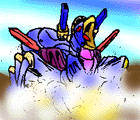


 |  |  |
|---|
| ||
|---|---|---|
| Fnerfs are six-limbed "fox'taur" creatures, possessing two arms on an upper semi-humanoid torso, and four legs on a lower "non-anthro" body. In shape, Fnerfs look like the centaurs of Earth mythos, only with their lower bodies suggesting those of foxes rather than horses, and their upper bodies covered in matching fox fur, and topped with a fox-like head, rather than a human head. Fnerfs are primarily found in the Ashdod Territories and surrounding areas, living an agrarian lifestyle, typically shepherding herds of rughrats, which they depend upon for meat, wool and leather. | ||
 Scattered across Sinai are regions known as the Forbidden Zones, so named because no sane airship captain would ever steer his vessel into this area. Those who venture in fall victim to mysterious accidents. The "Zones" are not immediately visible or special in any way from a distance ... but once one flies INTO such a zone, the scenery changes dramatically, as the sky darkens, webs of lightning spread about ... and things generally get unpleasant. Scattered across Sinai are regions known as the Forbidden Zones, so named because no sane airship captain would ever steer his vessel into this area. Those who venture in fall victim to mysterious accidents. The "Zones" are not immediately visible or special in any way from a distance ... but once one flies INTO such a zone, the scenery changes dramatically, as the sky darkens, webs of lightning spread about ... and things generally get unpleasant.On the ground, there isn't necessarily anything special at all ... except that the persons known as "Exiles", when they arrive on Sinai, show up somewhere within these Zones, by some mysterious means. Forbidden Zones vary greatly in size, some of the more noteworthy (and especially large) ones including Shabar, Aeztepa, Bosch, the Forbidden Zone of Mount Dronnel, and Xenea Canyon (site of the City of Hands). Other Zones have been discovered, among other places, in the Vykarin Wastes, the Wandering Roams, the Himaat, Himar, and the Desolate Band. | ||
| ||
 Fortunatis is officially considered the sixth planet from the sun, although in truth its orbit is highly irregular, thus throwing off attempts at accurately assigning numeric positions to the nine known planets of the solar system. Its appearance changes wildly as well, in color and (if one has rare telescopic equipment), surface pattern, as viewed from Sinai. Fortunatis is officially considered the sixth planet from the sun, although in truth its orbit is highly irregular, thus throwing off attempts at accurately assigning numeric positions to the nine known planets of the solar system. Its appearance changes wildly as well, in color and (if one has rare telescopic equipment), surface pattern, as viewed from Sinai. Fortunatis is one of the worlds that has been visited through the Gateway Tower, and it is reported that its surface does indeed change regularly, and it is deemed so unstable that it has been declared quarantined by authority of the Rephidim Temple. (The Kampfzengruppe and the Khattan Emirate are more in a position to have authority over the Gateways, but it seems that they have agreed with the Temple's assessment on this matter, as no further expeditions have gone there, to anyone's knowledge.) The planet is strongly associated with matters of luck and fate and is a factor in all sorts of popular attempts at telling portents of the future. Its "official" name changes regularly, as determined by the Sphere of Chaos (Chaos, Sphere of), to which it has special meaning. However, since the average citizen isn't able to or interested in keeping up with these seemingly random name changes, it is commonly known as "Fortunatis". Fortunatis is also one of many names for the god of luck (good and ill) and wealth, in the Olympian Pantheon. Fortunatis is often depicted as a "trickster god", though in myth he seems to compete with Ariel for this role. | ||
| ||
 True or not, it is widely believed that all Foxes on Sinai are Exiles -- visitors from other worlds who arrived here by way of the Forbidden Zones, or descendants of the same. Zerdas, the fennec-like beings from the Himaat, while occasionally called "Foxes", or mistaken for such (or vice versa), are generally accepted as being exempt from this assumption. The Keiltyn, a race of digitigrade, true 'red foxes' are also natives, but are nocturnal, (hence not always noticed) and tend to be remain quiet to other species about their heritage. True or not, it is widely believed that all Foxes on Sinai are Exiles -- visitors from other worlds who arrived here by way of the Forbidden Zones, or descendants of the same. Zerdas, the fennec-like beings from the Himaat, while occasionally called "Foxes", or mistaken for such (or vice versa), are generally accepted as being exempt from this assumption. The Keiltyn, a race of digitigrade, true 'red foxes' are also natives, but are nocturnal, (hence not always noticed) and tend to be remain quiet to other species about their heritage.
| ||
| ||
 Native to Lamu, but found in many areas all across Sinai, the fuff'nars are very odd creatures. Their appearance can best be described as 'cute'. They are about a foot to a foot and a half long, followed by a ringed tail that is equal to their bodies in length. Fur color is tawny beige, with reddish brown stripes marking their back and legs. Scavengers by nature, they usually travel in small packs and live off the pickings of larger predators. They are capable of bringing down their own prey if their numbers are great enough in a particular pack. Native to Lamu, but found in many areas all across Sinai, the fuff'nars are very odd creatures. Their appearance can best be described as 'cute'. They are about a foot to a foot and a half long, followed by a ringed tail that is equal to their bodies in length. Fur color is tawny beige, with reddish brown stripes marking their back and legs. Scavengers by nature, they usually travel in small packs and live off the pickings of larger predators. They are capable of bringing down their own prey if their numbers are great enough in a particular pack. For some reason, many nobles have taken to procuring fuff'nars as pets. If kept well fed, they've proven to be tame and affectionate -- although if they go for any length of time without food, there's an excellent chance they'll attack their owner. Thusly, when the fuff'nar owmer decides to take the pet for a walk... it's a good idea to keep them muzzled. Fuff'nars have one amazing trait; they can actually mimic a person's voice -- often repeating words said to it by the master. They tend to pick up words relating to their lifestyle and scavenger nature, usually words like "dead" and "kill". | ||
| ||
| Gallahs are "mutt" (mixed breed) canine anthropomorphs hailing primarily from Gallis, though they are also found in significant numbers in Rephidim City. In Gallis, they comprise the bulk of the "lower class". In terms of racial abilities and attributes, while some may sport dog-like senses, by and large they are close to human capabilities. | ||
| ||
| | ||
| ||
| Gallis is a country located in the region known as Nordika, on the northern part of the continent of Ai. It touches the southern part of the western border of Chronotopia, and is bordered on the north by the wilderness land of Sylvania. Its eastern borders touches the fringes of the mountains that border the Forbidden Zone of Bosch as well, though it has far less contact with that realm than Chronotopia. Gallis' culture is ostensibly a democracy, but, in practice, it is a sham of a republic, actually dominated by an elite aristocracy. Its populace is dominated by various "dog" races found in breeds that correspond to dog breeds found on our own Earth, continued by a very rigid legal structure that greatly regulates marriage. Those who are born outside of these strictures are seen as "mongrels" or "mutts" and make up the very lowest classes of the peasants, given very little concern -- or rights. Presently, the upper class is dominated by poodles and a small consortium of other breeds, as well as the peacock- like Kujaku who can be found in positions of authority here and there. (Gallis is very big on outward appearances, and Kujakus simply look wonderful by Gallisian standards.) Culture-wise, Gallis borrows heavily from what would on Earth be pre-Revolutionary France, with a bit of the pseudo-medieval and even the more recent thrown in. Art is highly valued there, and much wealth goes into museums and monuments. The most celebrated of Gallis' warriors are the Chevaliers (mounted warriors) and the Cuirassiers (armored foot warriors), notable for their extravagantly decorated armor and caparisoned drokar mounts -- and high-class notions of chivalry. (Unfortunately, this does not include respect toward the lower classes...) While Rephidim Standard is in use in some areas, Gallisian is the language of choice here. | ||
| ||
| Let the buyer beware! This is a common phrase to be found in Rephidim market- places, a derivative of "good enough?" If one party asks "gehnoh?" and the other ascents, then that is traditionally considered to close the deal. Some unscrupulous merchants (and there is no shortage of those) may slip "gehnoh" into a barrage of statements, and any nod or indication of the affirmative to any one of those points may end up committing the unwary customer to the whole "bargain". In general, if one is asked "gehnoh?" quite likely, no, it isn't "good enough". | ||
| ||
| (not common knowledge outside of Babel and religious circles) According to the myth of the Birth of the Seven Sisters, this name (which can be roughly translated as "Health" or "New Life") was the former name of Gorphat, Goddess of Affliction, before she and her sisters rebelled against and slew Bael, the Creator God. | ||
| ||
 Along the east coast of the continent of Ur is a region known as the Gigi Coast, where can be found a subrace of Khattas known as "Gigis". These golden-furred felines, quite unlike most of their brethren, actually LOVE the water, and are reasonably adept at fishing, diving and -- especially -- surfing. While they have no racial aptitudes in any of these areas (in the same way as, say, otters might), a "native-born" Gigi is bound to be proficient in one or more of these activities. Along the east coast of the continent of Ur is a region known as the Gigi Coast, where can be found a subrace of Khattas known as "Gigis". These golden-furred felines, quite unlike most of their brethren, actually LOVE the water, and are reasonably adept at fishing, diving and -- especially -- surfing. While they have no racial aptitudes in any of these areas (in the same way as, say, otters might), a "native-born" Gigi is bound to be proficient in one or more of these activities.One other distinguishing feature about the Gigis is that they are prone to what might be called "jabberwockyisms". Though their native language is ostensibly Rephidim Standard, they freely invent new "slang" terms on the spot, the meaning of which is generally determined based upon the tone in which the word is said, and in the context of the situation. While such words are typically used once and may never be used (except by accident) again, it is considered to be a sign of some pride if a word invented by a Gigi is picked up by others. Hence, this peculiarity of Gigi communication plays a role in establishing and reinforcing the Gigi social order. To outsiders, however, it is merely confusing and often annoying, hence the usage of the term "Gigi" to be synonymous with "nonsense" or "gibberish" in several other cultures in the region. | ||
| ||
 Golems are rare manifestations of some of the more powerful magic to be found on Sinai -- animated constructions of various elements created by accomplished mages to do their bidding. These beings have no self-awareness, and are therefore capable of great feats of "bravery", having no care for their own (usually very short) existence. Consequently, they're typically phenomenally stupid as well ... though some are rumored to possess something of the intelligence and perhaps even personality of the mage that created them. Golems are rare manifestations of some of the more powerful magic to be found on Sinai -- animated constructions of various elements created by accomplished mages to do their bidding. These beings have no self-awareness, and are therefore capable of great feats of "bravery", having no care for their own (usually very short) existence. Consequently, they're typically phenomenally stupid as well ... though some are rumored to possess something of the intelligence and perhaps even personality of the mage that created them.
| ||
| ||
| This is the former headquarters for the Knights Templar, who were once considered to be the elite warriors of Rephidim Temple. It consists of a main fortification cut into the base of Rephidim's central mountain, on the side opposite the city, and is surrounded by what once served as training grounds and a number of other buildings known as Sanctuaries -- symbolic bases for the various Lances of the different Aspects of the Order of the Bounded Star and Anchor. Little is known of what is inside the fortification, but it is said that the main chamber is dominated by a glowing pool of fire, and that the walls sport randomly placed stained glass windows bearing the crests of all of the Aspects ever created for the Order. Now, Golgotha is still used as training grounds for use by the Order, but its base of operations has moved to the sky island of Fetiss, after a schism with the Rephidim Temple. | ||
| ||
 Goliaths are large roaming creatures, a blend of technology and organic beings, accompanied by bands of much smaller creatures known as Zaccis (or Zakis). While they occasionally display high intelligence for a beast, they are generally accepted as being nonsapient -- and typically very violent upon encountering other beings on the Wandering Roams. Goliaths are large roaming creatures, a blend of technology and organic beings, accompanied by bands of much smaller creatures known as Zaccis (or Zakis). While they occasionally display high intelligence for a beast, they are generally accepted as being nonsapient -- and typically very violent upon encountering other beings on the Wandering Roams.
|
| Home Page |
Player Guide |
Log Library |
Recent Logs |
|---|---|---|---|
| Encyclopedia |
Dramatis Personae |
Art Gallery |
Moz Ezley Asylum |